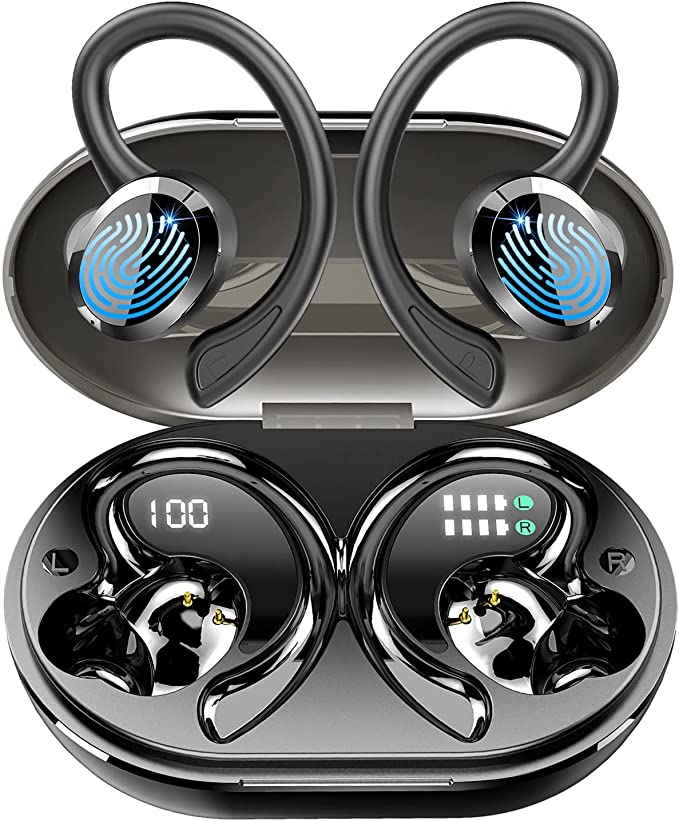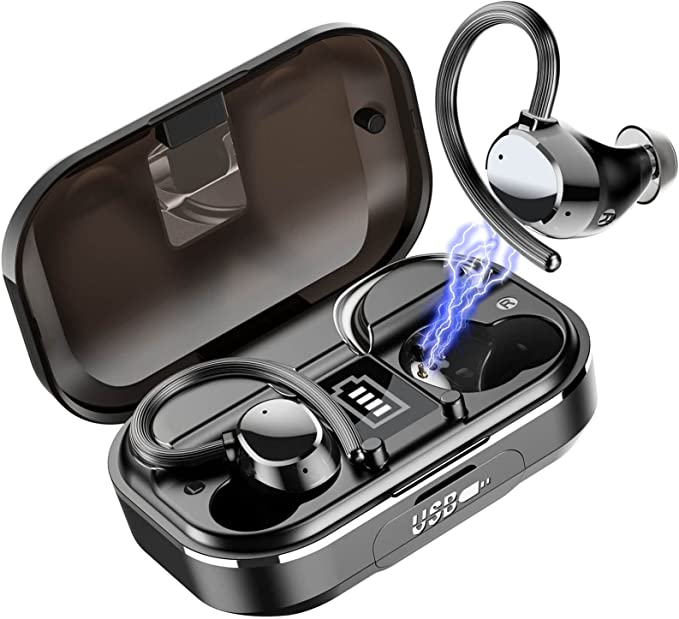The world pulses with rhythm, whether it’s the pounding beat of your favorite running track, the engaging narrative of a podcast during your commute, or the crucial instructions from a coach during training. For many of us, wireless earbuds have become essential companions, liberating us from tangled cords. Yet, the path to audio freedom isn’t always smooth. Earbuds that slip during a sprint, connections that stutter mid-song, or the dreaded low-battery warning right when you need them most – these are familiar frustrations, especially for those who lead active lives.
Enter the plethora of options like the Rulefiss Q38 Wireless Earbuds. They arrive promising a blend of stability, endurance, and resilience, specifically targeting the needs of sports enthusiasts and active individuals. But beyond the bullet points and marketing claims, what’s actually going on inside these compact devices? As someone fascinated by the intersection of technology and human experience, let’s put the Q38 under a virtual microscope. We’ll dissect the technologies it employs, explore the scientific principles behind them, and understand how they aim to deliver a seamless audio experience, all based on the information provided by the manufacturer. This isn’t just about one product; it’s about understanding the technology that’s becoming increasingly woven into the fabric of our daily activities.

The Unseen Connection: Making Sense of Bluetooth 5.3
At the core of any wireless earbud lies Bluetooth, the invisible thread connecting your audio source to your ears. The Q38 earbuds utilize Bluetooth 5.3, a specific iteration of this ubiquitous standard. Think of Bluetooth like a dedicated, short-range radio communication system. Each new version aims to improve this wireless highway. According to Rulefiss, Bluetooth 5.3 in the Q38 is designed to offer several key advantages over older versions: a “more stable connection,” “lower latency,” and “lower power consumption.”
What does this mean in practice?
* Stability: A more stable connection translates to fewer annoying dropouts or stutters in your music or calls, especially crucial when you’re moving around or in environments with potential wireless interference. It’s like having a clearer, less congested lane on that radio highway.
* Lower Latency: Latency refers to the delay between the audio signal being sent from your device and you actually hearing it. Lower latency is vital for watching videos or playing games, ensuring the sound syncs properly with the visuals. High latency leads to that jarring experience where lips move out of sync with dialogue. Bluetooth 5.3 aims to minimize this lag.
* Lower Power Consumption: More efficient data transmission means the Bluetooth radio in the earbuds (and potentially your phone) doesn’t have to work quite as hard, which can contribute to longer battery life. The system effectively “sips” power rather than guzzles it.
Furthermore, the Q38 features what’s described as “One-Step Pairing.” This convenience is typically enabled by True Wireless Stereo (TWS) technology. When you first take the earbuds out of their case, they perform a quick digital handshake with each other – establishing a primary and secondary bud – before the primary earbud makes the connection to your phone or device. Once this initial setup is done, taking them out of the case should ideally trigger an automatic reconnection to your paired device, getting you to your audio almost instantly. This intricate dance happens seamlessly in the background, simplifying the user experience.

Staying Power: The Art and Science Behind a Secure Fit
Perhaps one of the most significant make-or-break factors for sport earbuds is fit. An earbud that constantly feels loose or actually falls out mid-activity is not just annoying; it can disrupt your focus and flow. The Rulefiss Q38 directly addresses this with its sport earhook design.
This isn’t just about randomly adding a piece of plastic. There’s a good deal of ergonomic and biomechanical thought behind this approach. Your ear’s complex shape, particularly the outer structure (the pinna), provides natural contours. The earhook is engineered to loop over and gently hug the top and back of the pinna. This creates a crucial secondary point of contact and leverage, effectively “anchoring” the earbud against the forces of gravity and the jarring movements inherent in activities like running, jumping, or high-intensity interval training. It combats the tendency for the in-ear portion alone to wiggle loose due to sweat and motion.
Material science plays a vital role here too. The product description mentions “adjustable and secure-fit silicone earhooks,” and a user Q&A clarifies the material is likely TPU (Thermoplastic Polyurethane). Both silicone and TPU are popular choices for this application because they offer a unique blend of properties:
* Flexibility: They can bend and conform to the unique shape of different ears without causing undue pressure or discomfort, crucial for long wearing periods.
* Softness: A gentle touch against the skin prevents irritation.
* Grip: These materials possess a degree of natural tackiness or friction, which helps them stay put against the skin, even when moisture (like sweat) is present.
* Durability: They are generally resistant to wear, tear, and degradation from sweat or oils.
The combination of the physical hook structure and the properties of the chosen material work synergistically to provide a fit that aims to be both secure and comfortable, allowing the user to focus entirely on their workout or activity, not on constantly fiddling with their earbuds.
Tuning In: Exploring Sound Quality, Drivers, and the Nature of ‘Noise Cancelling’
While fit keeps them in, the ultimate purpose of earbuds is delivering sound. The Q38 description highlights “HiFi Stereo Sound Quality.” “HiFi,” or High Fidelity, is an audiophile term that essentially signifies an aspiration: to reproduce sound as faithfully as possible to the original recording, without coloration or distortion. It’s a goal, rather than a strictly defined technical standard, especially in consumer audio.
The sound itself is generated by drivers – tiny speakers inside each earbud. The Q38 is equipped with 10mm dynamic drivers (one per earbud; the description mentioning “four 10mm high-efficiency speakers” likely refers to the total components involved, but standard stereo implies two drivers). A dynamic driver works much like a traditional loudspeaker, using a diaphragm attached to a voice coil within a magnetic field to vibrate and create sound waves. Generally speaking, a larger driver diameter (10mm is reasonably substantial for an earbud) has the potential to move more air, which can contribute to a more robust bass response and potentially a fuller overall sound.
Rulefiss claims the Q38 delivers “punchy bass,” a “full and textured midrange,” and a “balanced and natural sound with superb dynamic range and accuracy.” This describes a specific tuning target – aiming for impactful low frequencies without overwhelming the vocals and instruments (midrange), and maintaining clarity across the spectrum. Achieving this balance depends heavily on the quality of the driver itself, the acoustic design of the earbud’s casing, and the digital signal processing (if any) applied to the audio signal. How well it meets this HiFi aspiration is subjective and depends on the listener’s preferences and the quality of the audio source.
It’s also crucial to address the term “Noise Cancelling.” In the context of earbuds like the Q38, which don’t explicitly mention microphones for monitoring external sound (a hallmark of Active Noise Cancellation), this almost certainly refers to Passive Noise Isolation. This is achieved by the physical design of the earbud tips sealing the ear canal. Much like wearing well-fitting earplugs, this physical barrier blocks a significant amount of ambient sound from entering your ear. It’s particularly effective against steady-state noises like engine hum or air conditioning. While highly beneficial for immersing yourself in your audio and reducing distractions, it’s fundamentally different from Active Noise Cancellation (ANC), a more complex technology that electronically counteracts external noise. Understanding this distinction helps set realistic expectations. The Q38 aims to quiet your surroundings through its physical seal, not through electronic wizardry.

Fueling Your Flow: Untangling Battery Life and Charging Convenience
A dead earbud mid-workout is the definition of anticlimax. Battery life is therefore paramount. The Q38 claims a playtime of 6 to 8 hours on a single charge for the earbuds themselves. This duration is quite respectable and should comfortably cover most workouts, commutes, or several hours of focused work.
However, the real endurance story comes from the charging case. With its stated 800mAh capacity, it acts as a portable power bank, capable of recharging the earbuds multiple times on the go. This extends the total potential listening time to a claimed 48 hours before the case itself needs recharging. This significantly reduces “battery anxiety,” meaning you might only need to charge the case perhaps once a week, depending on your usage patterns. Inside these devices, you’ll typically find Lithium Polymer (Li-Po) batteries, favored for their ability to be molded into the compact shapes required for earbuds and cases, while offering good energy density.
A particularly user-friendly feature described is the Dual LED Digital Display on the charging case. This small screen provides an immediate visual indication of the case’s remaining battery level, usually as a percentage (1-100%). Often, it also shows the charging status of the individual earbuds when they are docked inside. This eliminates the guesswork often associated with simple indicator lights (is one blinking light 25% or 50%?). You know precisely where you stand in terms of power.
When it finally is time to recharge the case, the Q38 utilizes a USB Type-C port. This is the modern standard for charging many electronic devices, and its inclusion is a welcome convenience. Type-C connectors are reversible (no more fumbling to plug it in the right way) and generally support faster charging speeds compared to the older micro-USB standard. Rulefiss states the case can be fully recharged in just 1.5 hours using “type-C quick charge,” getting you back to full power relatively swiftly.
Weathering the Workout: Decoding the IP7 Waterproof Rating
Activity often involves sweat, and sometimes, unpredictable weather. Earbuds designed for sports need to withstand moisture. The Q38 carries an IP7 waterproof rating. Understanding IP ratings helps clarify what this means. “IP” stands for Ingress Protection. The first digit rates protection against solids (like dust), and the second rates protection against liquids. An ‘X’ often means it hasn’t been rated for solids.
The ‘7’ in IP7 is the crucial part here. According to the official standard, an IP7 rating means the device is protected against the effects of temporary immersion in water. Specifically, it should withstand being submerged in up to 1 meter (about 3.3 feet) of water for up to 30 minutes.
What does this mean in the real world for the Q38?
* Sweat is no problem: Heavy perspiration during intense workouts won’t harm them.
* Rain is okay: Getting caught in a downpour during a run shouldn’t be an issue.
* Accidental splashes or spills: Dropping them briefly in a puddle or spilling a drink on them should be survivable.
However, it’s important to note what IP7 doesn’t mean. These earbuds are not designed for swimming. Prolonged submersion, submersion at greater depths, or exposure to pressurized water (like a shower jet) could exceed the protection level and cause damage. But for the typical moisture encountered during land-based sports and activities, the IP7 rating provides a solid level of assurance and durability.
Effortless Control: The Subtle Science of Touch
Fiddling with small buttons on an earbud while you’re moving can be clumsy. The Q38 incorporates Smart Touch Controls, relying on capacitive sensing technology. Your skin is naturally conductive and holds a small electrical charge. The touch-sensitive panels on the earbuds create a small electrical field. When your finger approaches or touches this panel, it changes the capacitance of that field. The earbud’s internal processor detects this change and interprets it as a command.
This allows for intuitive, button-free operation. According to the description, simple taps or holds on the touch panels can control a range of functions:
* Playback: Play or pause music/audio.
* Volume: Adjust volume up or down (often by holding on the right or left earbud, respectively).
* Calls: Answer, end, or reject incoming phone calls.
* Voice Assistant: Activate your phone’s native assistant (like Siri or Google Assistant) with a specific gesture (e.g., a triple-tap).
This direct control from the earbud itself enhances convenience significantly, allowing you to manage your audio and calls without breaking your stride or needing to pull out your phone.
Beyond the Core: Seamless Use and Keeping Things Running
Modern wireless earbuds often include thoughtful usability features. The Q38 description highlights the ability to seamlessly transition between single mode and dual mode. This means you can use just one earbud (left or right) for mono audio or calls – perhaps to keep one ear open to your surroundings – and if you take the second earbud out of the case, it should automatically connect and switch to stereo sound without interruption.
The manufacturer also provides some practical advice for long-term use, touching on basic electrical science. They mention that over time, the magnetic charging contacts on the earbuds and inside the case can become oxidized or dirty (from sweat, dust, skin oils). This can impede proper charging or even prevent the earbuds from turning on. The recommended fix is simple: gently clean these contacts using an alcohol wipe. This removes the insulating layer of grime or oxidation, restoring good electrical conductivity for reliable charging. They also include instructions for resetting the earbuds if pairing issues arise, a common troubleshooting step for wireless devices. These small details contribute to the overall user experience and longevity of the product.

Conclusion: The Sum of the Parts – Technology Serving the Active User
Looking at the Rulefiss Q38 through the lens of its claimed technologies reveals a device designed with a clear purpose: to provide a reliable, convenient, and durable audio experience for people on the move. The synergy of its components aims to address common pain points for active users. The potential stability and efficiency of Bluetooth 5.3 target uninterrupted listening. The ergonomic earhooks crafted from flexible materials tackle the crucial issue of secure fit during vigorous activity. The 10mm drivers aim for engaging sound, while the passive noise isolation helps users focus. The extended battery life powered by the high-capacity case with its informative LED display combats charging anxiety. The IP7 rating offers resilience against the elements and exertion. And the touch controls provide effortless command.
While the ultimate performance and longevity of any device depend on numerous factors including build quality and individual usage, the combination of features described in the Rulefiss Q38 exemplifies a significant trend in consumer electronics: technologies that were once premium are becoming increasingly accessible. Understanding the science and engineering packed into these small devices not only helps in making informed choices but also deepens our appreciation for the technology that seamlessly integrates into, and hopefully enhances, our daily lives and active pursuits.



